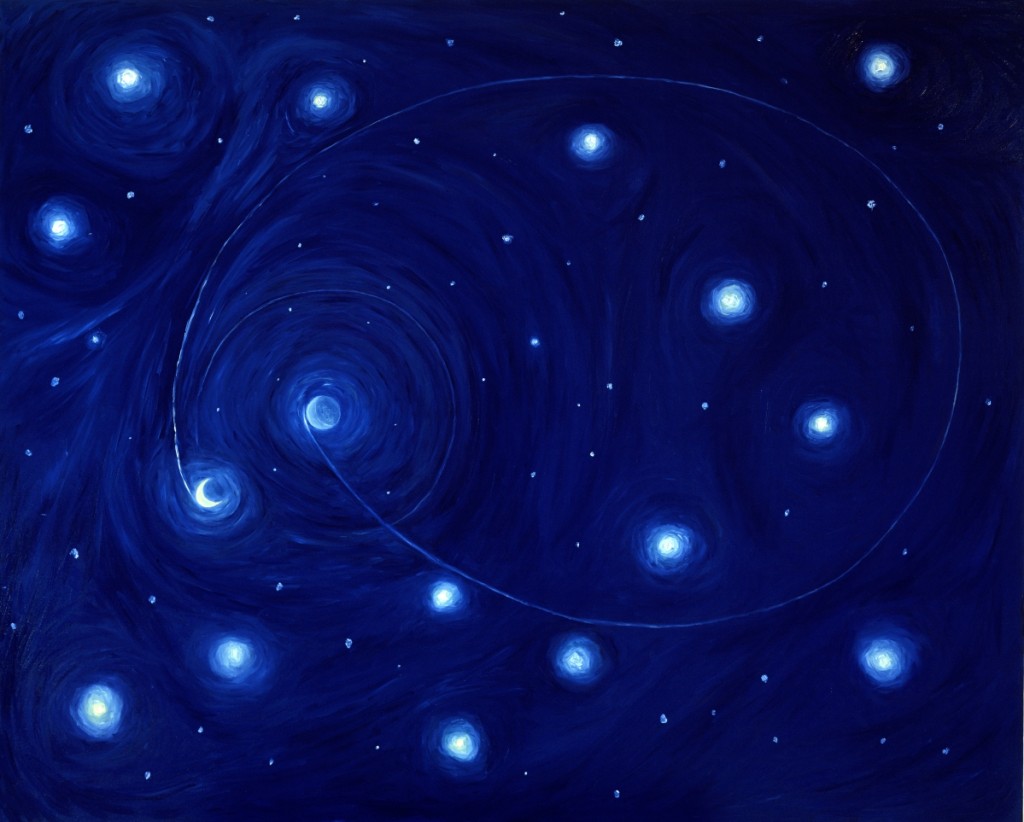On November 14, artist and former NASA scientist Ed Belbruno’s Painting the Way to the Moon (2015), an award-winning, hour-long documentary, will screen at Agora Gallery in New York City. That’s only about 50 miles away from the Princeton, N.J., mathematician and artist’s home, but Belbruno has used his artistry to travel a much greater distance through space and time – a trajectory that catapulted him from math professor to Jet Propulsion Lab (JPL) employee to abstract expressionist artist. Antiques and The Arts Weekly caught up with Belbruno in advance of the screening and an exhibition of the artist’s work running at the gallery November 2-22 to talk with him about that journey.
JPL has a history of launching things. Did it launch your art career?
No, I did my first and very serious oil painting when I was 5 years old. It was actually featured in a group art show in New York City three years ago. They used the painting to advertise the entire art show. So JPL didn’t launch my art career. What they launched was my scientific career more than anything else. It really took off after that.
You were working at NASA’s JPL in Pasadena by day and making space- inspired paintings by night. What question were you trying to answer in your art?
A way to get to the moon with less fuel. We’ve always known how to get there, of course, and the initial idea goes back to the German engineer, Walter Hohmann, who early in the Twentieth Century was discovering new ways to get to the planets before we even had spaceships. He came up with a route to the moon that takes three days, and this was used in the Apollo missions. It’s called the Hohmann Transfer. The disadvantage is that when you get to the moon it requires a lot of fuel to slow down and go into orbit around the moon.
How did you wind up at JPL?
I was a professor at Boston University, but I got bored very quickly – I was doing more art than anything else. When JPL offered me a job, I started thinking about this fact that you have to slow down. It costs about $1 million per pound to bring anything to moon, including fuel, so if you have an Apollo-size spacecraft, it requires about 200 pounds of fuel – that’s a quarter of $1 billion just to slow down. What my work does is it finds ways to the moon where you don’t have to slow down, the moon just automatically pulls you in.

“Route to the Moon,” 1991, oil on canvas, 56 by 70 inches. This image is the route to the moon used by Japan.
Bet NASA was happy to learn of a cheaper solution.
There’s a lot of politics involved with that because when I came up with the idea in 1986, they actually discouraged me from working on it – for a couple of reasons – one, they said, ‘Well, we already know how to get to the moon, it takes three days and we’re fine with that.’ Second, because my methods and ideas in Chaos Theory were so different, they didn’t want to get involved with it. JPL, like all NASA centers, is both private, technically CalTech but also government in the sense that they are a NASA center. They rely on our Congress for their budget, which is a couple of billion dollars a year. So they don’t want the word ‘chaos’ associated with them.
Luckily, you had a chance to validate your work with a rescue of a Japanese spacecraft four years later, right?
Absolutely. It was like a message from the Universe. It was April 1990 and I was leaving JPL since they had little faith in my work on new, fuel-efficient ways to the moon. I heard a knock at my door and an engineer told me of a failed Japanese mission to the moon. You see, Japan wanted to be the third country to send something to the moon, after the United States and the Soviet Union. Two months earlier they sent two robotic spacecraft into Earth orbit. One was a relay to stay in Earth orbit and the other was to go to the moon. Well, it never made it there. The engineer told me the Japanese wanted to see if the other spacecraft in Earth orbit could be used to go the moon and salvage their mission. Problem was it had almost no fuel. He said Japan was desperate and he wanted to see if my weird chaos ideas might work. Eureka! This was my moment. Suddenly the idea flashed in my head how to find a novel way to the moon with no fuel. He didn’t believe that it would work, but to his surprise, it did in a computer simulation. This route was based on a painting I had done. One year later, Japan put its spacecraft, renamed Hiten, on this trajectory and it successfully arrived October 2, 1991.
Tell us a bit more about your tough days at JPL.
Well, you know the role of JPL is NASA’s center for interplanetary robotic space exploration. They are the best in the world at it. All those missions that people see, the Rovers on Mars, pictures from Saturn and Jupiter – that’s all from JPL. When I was hired there in 1985 after leaving my professorship at Boston University, it was quite a change because I went from being a research mathematician to an engineer. I immediately felt that it wasn’t for me, but in the end it worked out very well. I was hired for a division at JPL called the Outer Planet Group and those were the people who designed trajectories for getting spacecraft to various destinations for planets beyond Mars. My initial job there was to work on the Galileo mission to Jupiter. Typically, I would get up at 8 am, go in about 9. Like everyone else in these places, you have a cubicle and a computer. Basically, what they wanted me to do was simulate trajectories from the Earth to Jupiter.
Hmm, sounds a bit rote.
I loved the novelty of it, but even though it sounds interesting to send spacecraft to Jupiter, if you’re a trajectory person on a team of five or six people, you literally sit there all day long propagating one trajectory after another after another and then tabulate the results in an Excel file. After a while it became very repetitious for me. That was actually good, though, because I got bored enough that when I left my job at the end of the day, I started to think about this problem of how to get to the moon with less fuel. And that’s when I turned to my oil paints and canvas and made my breakthrough. I did a painting with the intention that if I did it quickly enough, I would see a pattern. When I translated the pattern into numbers on the computer, this route was revealed.
Is oil your preferred medium?
I started that way like a lot of people. I work in oil and acrylic and mixed media, oil on top of acrylic or pastel on top of acrylic. Typically, I like working with acrylic.
And space your preferred subject?
When I was 5 years old, my mother was shopping one day and I just walked into an art store in New London, Conn., where I grew up. I just knew what to get – tubes of paint, a little canvas – went home and painted a spaceship. It came out really good. So, yes, I started out as an “oil snob” looking down at everything else. I dabbled a bit with acrylics but back then they weren’t what they are now. Back then, when they dried they would color-shift tremendously and the texture was not very good. In the past ten years, however, there have been huge advances in acrylics – fantastic texture, very opaque and they don’t color-shift at all.
Did you start out doing more photorealistic paintings and then move to abstract?
From about the ages five to 11 or 12, I was doing realistic pictures that, because I liked space so much, had space themes. One I did when I was 11 was a picture of being on the satellite Titan looking at Saturn in the sky. I was inspired actually by Chesley Bonestell, a famous American astronomical artist. He was used a lot on Hollywood sets to paint the realistic space scenes in the early movies. The old Hayden Planetarium in New York had a Bonestell painting of this Titan scene with Saturn in the background. I saw this as a kid, and I did one of my own. And it came out just as good (laughs). Over the years, my style has evolved considerably, and now my work is quite abstract and I do not focus on space.
After I left JPL in 1999, I had the opportunity to meet the director of NASA, Dan Goldin. Senator Tom Harkin had suggested that I meet him because of the way I had been treated at JPL; Goldin commissioned me to do “Starscape Over Mountains on Another World.” He personally unveiled that painting, which is in the NASA Smithsonian collection. It sits next to works by Warhol and other stars of the art world.
American astrophysicist and author Neil deGrasse Tyson is joining you at the Agora Gallery screening. How did that come about?
I set that up. Tyson, director of the Hayden Planetarium at the Rose Center for Earth and Space in New York City, is very familiar with my work. He wrote the foreword for my book, Fly Me to the Moon, An Insider’s Guide to the New Science of Space Travel.
You balance your art career with positions at both Princeton University and Yeshiva University. What other projects are you involved with?
I just wrote an article for Scientific American and they’re going to be publishing it soon. It’s called “Art and Mathematics: A Personal Perspective.” What they wanted to know was what is going on with me when I do math and I do art and how do I think those two fields are related. Doing the art, I’m completely in the art mode. So I go into the zone and I become the scene. I’ll start painting at 9 am and I’ll start getting hungry, thinking it’s 11 and it’s actually four in the afternoon. When I’m in the math mode, it’s painful because you have to turn off the creative and be purely logical. I think that comes out in the documentary that will be shown at Agora Gallery, along with an exhibition of my art. It’s a stunning setting, and I am honored that this film has showcased my achievements and proud that my work is a bridge between both the arts and sciences.
-W.A. Demers
[Ed note: Agora Gallery is at 530 West 25th Street. Tickets for the November 14 event are available through Eventbrite – https://www.eventbrite.com/e/painting-the-way-to-the-moon-tickets-75016659849].



_low_res-1024x831.jpg)
)-1024x765.jpg)



